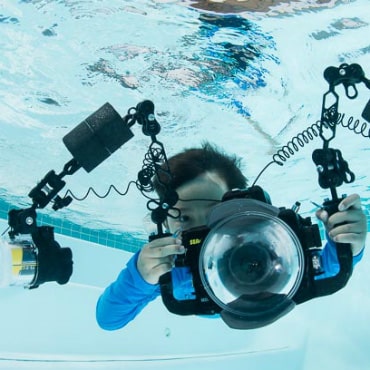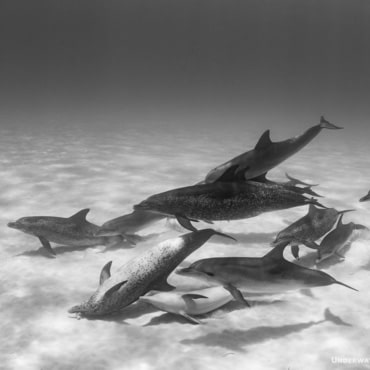Fujifilm X-T3 Camera First Impressions
April 10th, 2019
Fujifilm X-T3 First Impressions
Fujifilm is a very specific brand with a very specific following. They harken back to the older days of photography with retro designs, film simulations, and an alternative sensor type. As the world turned digital, Fuji was slow to follow. This made produced the shift where Fuji went from top-dog to underdog in the span of a couple decades. Nikon, Canon, Sony, Olympus, and Panasonic rose to the forefront of photography and, specifically, underwater photography. But Fujifilm’s recent release of the X-T3 just might put Fujifilm on track for entering the underwater world in the digital age with serious talking points.
Although the X-T2 had a few housing options, the specs and lens selection at the time left it a poor choice for underwater photographers. The Fujifilm X-T3, however, boasts improved specs (rivaling other brands) and more X mount lenses. Will it be a popular camera for underwater photography? Probably not. But for those who love Fuji’s retro design, high quality APS-C glass, and film-style JPEG rendering – this could be a unique camera to take underwater.

Quick specs:
- 26.1 MP BSI X-Trans CMOS 4 sensor (APS-C)
- 425-point hybrid contrast/phase detection autofocus system
- Improved AF tracking (from the X-T2)
- Dual UHS-II SD card slots
- 20fps with an electronic shutter; 11fps with a mechanical shutter; 30fps in 1.25X crop mode with an electronic shutter
- 3.69M-dot EVF (electronic viewfinder)
- 10 bit internal video capture at 4K/60p (1.18x crop). 4K/30p can be used with full sensor size
- F-Log color profile internal video recording
- No image stabilization
- Native ISO 160-12800
- Max sync speed with flash: 1/250 sec
- 5.2 x 3.7 x 2.3" / 132.5 x 92.8 x 58.8 mm
- 1.19 lb / 539 g
- Retro dials and buttons
Shop all Fujifilm X-T3 Camera & Housing options.
Implications for Underwater Photography
One thing is for sure – the Fujifilm X-T3 will not be your typical underwater camera, and it likely won’t appeal to normal underwater photographers. But it certainly has great potential.
Pros
26.1 MP X-Trans CMOS 4 Sensor
The Fujifilm Z-T3 boasts the highest resolution APS-C sensor out there at 26.1 MP. That’s a lot of megapixels, which means high quality crops. For underwater photographers the X-T3 could prove excellent for underwater macro photography. The additional crop factor of the APS-C sensor is even beneficial for macro when the resolution is so high. The X-trans sensor is made specifically by Fujifilm whereas many other brands use Sony sensors. Fuji does its best to replicate the color science and image quality of the bygone film days. It’s one of the reasons Fuji fans shoot Fuji.

Fujifilm X-T3 with X-trans sensor
JPEG Rendering (Film Simulation Mode)
Many people love Fuji for their JPEG rendering. They also have a film simulation mode where they try to replicate film in their JPEGs. If you’re into film or Fujifilm as a brand and you want to skip the post production process – this could be a really cool option to use, especially underwater.
Improved AF Tracking
This is a big one for underwater photographers. Fujifilm claims the autofocus on the X-T3 is 1.5 times faster than the X-T2. They are also claiming to have better AF tracking over the X-T2. People reviewing the camera seem to agree with this and even claim thee AF tracking is as good or better than competing brands.
Electronic Viewfinder
The EVF on Fujifilm’s X-T3 boasts 3.69 million dot resolution, a display lag of 0.005 seconds, and a refresh rate of 100 fps. We hope these specs will also include a dynamic range good enough for underwater photography. In any case, it sounds like a highly functional EVF.
Ergonomics (Topside)
Many photographers shoot Fujifilm for the nostalgia. Fujifilm makes it easy to live in the good ol days with their ergonomics. It’s retro. Even the ISO has a designated dial. Fuji cameras are fun to use and a little more involved when it comes to control. How will it effect underwater shooting? It’s hard to tell, but certainly underwater housing manufacturers aren’t looking to go retro.

Fujifilm X-T3 Controls
Cons
26.1 MP X-Trans CMOS 4 Sensor
It’s possible that the sheer resolution of the 26.1 MP APS-C sensor could introduce issues similar to what we’ve noticed in the Nikon Z7. When you shove so many pixels onto a small(er) sensor, it introduces more noise. However, we haven’t taken photos underwater with this system yet, so we can’t confirm this. Sensor technology is always updating, and it’s possible this won’t be an issue.
Another issue with having an APS-C sensor is that many other manufacturers are moving to full frame mirrorless systems. Fujifilm will be hard pressed to do so as their line-u of lenses is all built for APS-C.
No Image Stabilization
For underwater photographers a lack of in-body image stabilization could be a big issue. When you’re shooting in a 3D, low light environment, it’s necessary to recover as many stops as possible in order to freeze the action. Although the video specs are good, I think a lack of image stabilization will be a deal breaker for some underwater videographers.
Available Lenses
There are good X mount lens options for underwater photography, at least more than were available with the release of the X-T2. However, they still aren’t great or expansive. I personally think that fisheye lenses are essential for wide angle underwater photography, but there isn’t an X mount fisheye available. Nauticam does offer a wet wide lens solution with the WWL-1. Macro options with the X mount lens is a little more exciting. Beyond the ok option of using a Carl Zeiss Touit 50mm macro, there is now a Fujinon 60mm f/2.4 and a Fujinon 80mm macro lens available.
Post Processing with RAW Files
If you’re an adobe user, you will be disappointed with the X-T3 RAW files. When processing on Adobe software, the RAW files develop wormy artifacts in the final product. For many people, that’s not acceptable. The remedy for this is to use certain processors like Capture One Pro. Not ideal if you’re committed to Adobe.
Implications for Video
There are very exciting and not-so-exciting prospects for video with the Fujifilm X-T3. 4K video at 60p is enticing at a 1.18x crop. But 4K with the full sensor is still 30p. 10-bit internal recording is great, and the F-Log profile will be appreciated by serious video shooters. There’s even a film simulation mode that introduces film-like picture profiles. But a lack of image stabilization doesn’t sound good to underwater videographers.
Available Lenses for Underwater Photography
X mount lenses have been pretty limited when it comes to options for underwater photography. However, Fujifilm continues to create new lenses. Here is a roadmap for the near future:

Wide Angle
- For rectilinear: Fujinon XF10-24mm f/4 R OIS wide angle zoom lens with the Nauticam 180mm Glass Dome Port and Zoom Gear (Nau-36441)
- For (Almost) Fisheye: Fujinon XF18mm f/2 with the Nauticam Flat Port 13 and Wet Wide Lens 1 (WWL-1)
Macro
- Zeiss Touit 50mm f/2.8 macro lens with Nauticam Macro Port 45 + Nauticam Mini Extension Ring 20 + Aperture Ring (Nau-36422) or Nauticam Macro Port 32 + Nauticam Mini Extension Ring 30 + Aperture Ring (Nau-36422)
- Fujinon 60mm f/2.4 macro lens with Nauticam Macro Port 45 + Nauticam Mini Extension Ring 20 + Aperture Ring (Nau-36422) or Nauticam Macro Port 32 + Nauticam Mini Extension Ring 30 + Aperture Ring (Nau-36422)
Fujifilm X-T3 Underwater Housing Options
Nauticam Housing for the Fujifilm X-T3
Fortunately, it’s easy to make a choice when it comes to underwater housings for the Fujifilm X-T3. There’s really only one reputable housing manufacture with an available housing and ports - Nauticam.
Nauticam has made an underwater housing for the third generation Fujifilm X-T3. The housing is milled from a block of solid aluminum, then hard anodized. It’s a rugged and reliable piece of gear that will stand up to saltwater and the can take a beating. The housing has a depth rating of up to 100m.

Nauticam X-T3 Housing Available now!
Who Should Buy the Fujifilm X-T3?
There’s no doubt that the Fujifilm X-T3 will only appeal to a niche group of underwater photographers. If you are fulling invested in the Fujifilm X-T3 with X mount lenses or a hardcore film/Fujifilm buff – well, this is the camera for you. It’s also a great option if you need the extremely high resolution in an APS-C senor at a reasonable price. But more than anything else, the X-T3 is an intriguing camera. The film simulation picture profiles have potential for interesting, film like underwater photography and video. It also has the potential to cut out prost processing for RAW if you do prefer these profiles. Despite this, the autofocus, image quality, and even burst specs are up to modern standard for a higher end mirrorless camera. So it’s not to say it isn’t a fabulous camera. It just doesn’t have the same massive support system and lens selection for underwater photography as other manufacturers. If you are thinking of other brands for underwater photography, I might look at those first. But if you want to veer from the mainstream, the Fujifilm X-T3 could be the camera for you.





